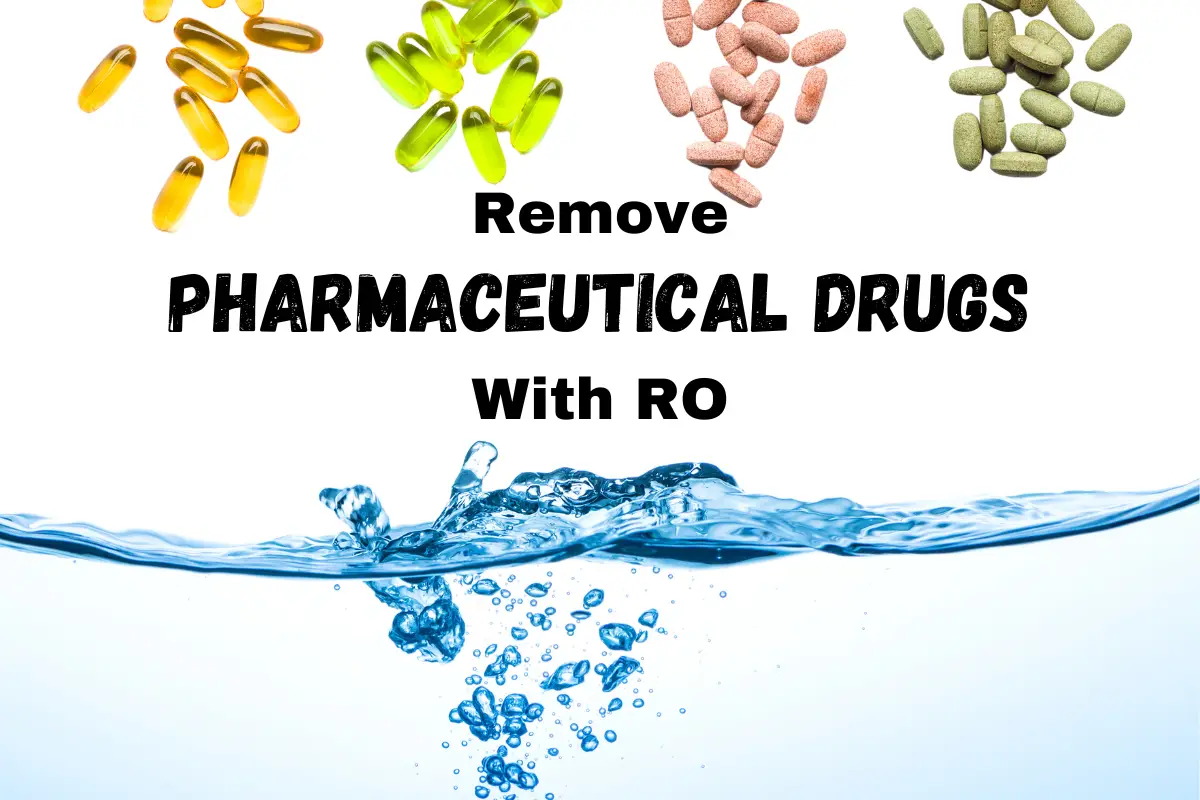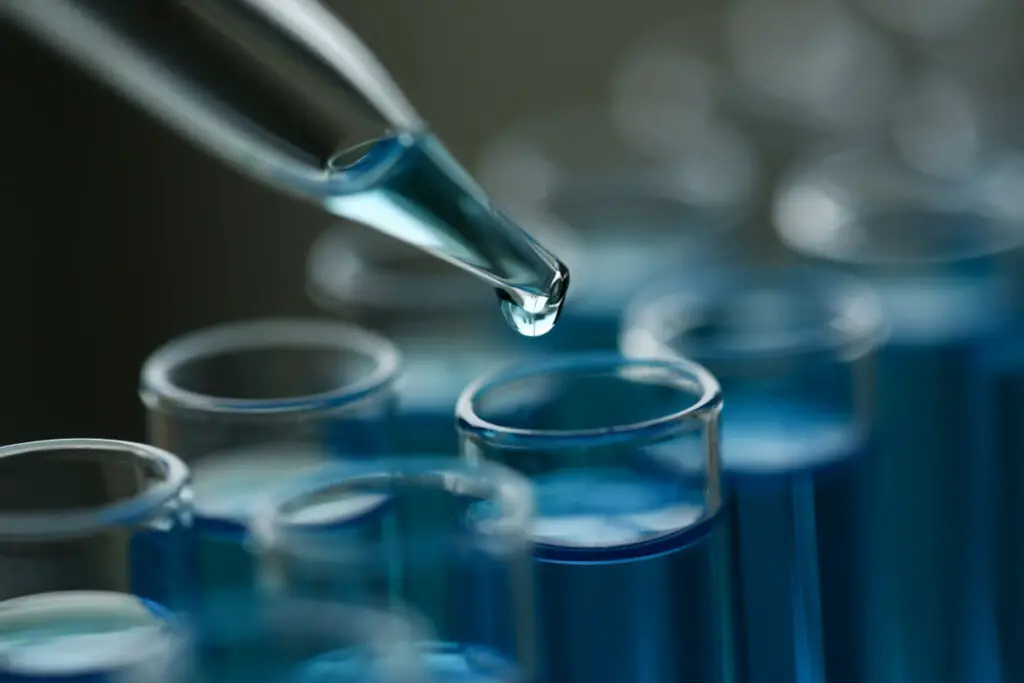Reverse osmosis can remove at least 97% of detectable pharmaceutical drugs, including antibiotics, antidepressants, painkillers, hormones and blood thinners. They are especially effective against endocrine disruptors, chemicals that interfere with our hormone balance.
Only two rivers in the entire world aren’t contaminated with pharmaceutical pollution. Samples taken from waterways in every continent show concentrations of drugs used to treat diabetes and epilepsy, along with antidepressants, antihistamines, anaesthetics and antibiotics.
In this article, we explain the effects of pharmaceutical drugs and hormones when ingested with drinking water. More importantly, we breakdown how reverse osmosis can keep you safe from these micropollutants.

How reverse osmosis removes drugs from our water
Research has found that reverse osmosis filtration systems can remove at least 97% of the pharmaceuticals and drugs found in our water (ref 2). It’s really effective against endocrine disrupting compounds (drugs that affect our hormone balance).
The high pressure membranes used in reverse osmosis are more effective at filtering pharmaceuticals from water than any other filtration system.
In fact, reverse osmosis is so good at removing contaminants that commercial ROs are used to produce water of such purity that it can be used as Water For Injection (WFI) and for the preparation of IV solutions.
However, RO systems are limited when it comes to removing some low-molecular weight organics, like the pain reliever acetaminophen.
But remember, it’s only in the last couple of decades that pharmaceuticals have been discovered in our drinking water. So, no specific filtration method had been thought of to specifically help remove these substances.
Other Water Filtration Methods
Fortunately, the water treatment plants that treat our city water have been able to remove some of the drugs without even meaning too. Their current methods for cleaning and disinfecting our water are already able to remove a few pharmaceuticals (though not all).
For example, chlorine (used to disinfect our water) is effective at clearing antibiotics such as sulfamethoxazole, trimethoprim and erythromycin.
Advanced water treatment processes like activated carbon and advanced oxidation are also able to remove some drugs, but they all have limitations. For example, activated carbon cannot remove very polar water soluble compounds like the antibiotic sulfamethoxazole.
Then AOPS (Advanced oxidation processes) are very effective but only in removing oxidizing pharmaceuticals and other trace organic chemicals (so some drugs but not all).
And, unfortunately the pores in the low-pressure membranes of microfiltration and ultrafiltration are insufficient to retain pharmaceuticals based on their size.
Reverse osmosis remains the best way to remove pharmaceuticals.
Drugs in our drinking water
Pharmaceuticals are therapeutic substances used, among other purposes, to prevent and treat diseases that affect humans and animals (livestock and pets).
Some of these chemicals are synthetically manufactured while others, like antibiotics, vaccines, insulin, and steroid hormones, are made from natural sources (plants and animals).
Whatever their origin, pharmaceuticals contain active ingredients. It’s these active ingredients that are designed to produce a biological effect on us, but they are also the part of the drug that can enter our water supply as a contaminant.
Recent advances in testing methods and equipment have allowed us to detect trace levels of pharmaceuticals in the environment and the water cycle for the first time. Trace levels are very small amounts, but can still be enough to impact us.
With time, more surveys and studies are confirming the presence of drugs in city wastewaters and drinking water.
For that reason, these bioactive chemicals, which include prescription, over-the-counter and veterinary drugs, have become known as microcontaminants. But, a lot of information is still needed to determine just how toxic these chemicals can be as they potentially build up in our water supplies.
Pharmaceutical pollution sources
Our lakes, rivers and streams are polluted with pharmaceuticals from several sources, including:
- wastewater effluent
- industrial waste
- medical waste from health-care and veterinary facilities
- runoff from animal-feeding operations
- landfill leachate
- biosolids
For example, the antibiotics used in the livestock industry as well as the drugs that people take are not fully metabolized in the body. The remainder is excreted in urine or feces, ending up in our wastewater.
Water can also get contaminated by personal care products like perfume, skin lotions and sunscreen that wash off people’s skin.
Studies conducted by the U.S. Geological Survey found pharmaceuticals (or drugs) in water bodies across the country, including acetaminophen, caffeine, cotinine, diphenhydramine and carbamazepine.
In fact, after studying hundreds of streams in 30 states, researchers identified drugs like
- antibiotics
- antidepressants
- blood thinners
- heart medications
- hormones (estrogen, progesterone, testosterone)
- painkillers
Other drugs that have been found in later studies include
- caffeine (which, of course, comes from many other sources besides medications)
- carbamazepine (an antiseizure drug)
- fibrates (used to improve cholesterol levels)
- galaxolide and tonalide (fragrance chemicals)
Toxic effects of drugs in our water
How dangerous having these drugs and hormones in our water and aquatic environments is, remains unclear.
While the World Health Organization has said that the concentrations are currently not enough to cause a pharmacological effect, and likely pose no risk to human health, these chemicals do already affect the health and behavior of wildlife, including insects, fish and birds.
More importantly, it’s believed there might be a cumulative effect on people from even tiny amounts of pharmaceuticals in drinking water. This means the more we drink drug-contaminated water, the greater the chance we will be affected by them.
Further research is clearly needed to determine the impact of chronic, low-level exposure to pharmaceuticals on our health. Hopefully, future research will focus on the potential reaction of pharmaceutical mixtures (rather than just one drug at a time), and also how they could affect sensitive populations like pregnant women, children and medical patients.
At the moment, the studies and reports show that concentrations of pharmaceuticals in surface water (rivers, lakes etc) and groundwater sources impacted by wastewater discharges are typically less than 0.1 µg/l (or 100 ng/l).
Concentrations in treated drinking-water are usually well below 0.05 µg/l (or 50 ng/l). This is below the minimum therapeutic dose, but as we discussed before, the cumulative effects are not known.
Plus, other studies (ref 1) have found pharmaceutical concentrations as high as 677 ng/L, with the highest being for caffeine and cholesterol.
A big problem, is that the amount or concentration of pharmaceuticals is incredibly different between different city water supplies and private wells. Which is why so many of us are concerned and what to remove them from our water – before we drink it.
How to know if your water contains pharmaceuticals
If your home water comes from a city water supply you can reach out to your utility to ask for the contaminants reports from their most recent tests.
However, an alternative is to contact a reliable laboratory to carry out a test to search for drugs and pharmaceuticals in your drinking water. While this is just an option for anyone on city water, it is absolutely essential for anyone that uses a domestic well.
The best way to know if there are drugs or pharmaceuticals in your water is with a certified laboratory test.
MyTapScore have a good quality drugs and pharmaceuticals home water testing kit for $229.00. It’s an expensive test but it covers a suite of 20 different pharmaceutical drugs, including endocrine disruptors.
- You get a kit and instructions on how to collect the samples.
- Shipping is included.
- Samples are tested in a certified laboratory and can detect concentrations to below 2 parts per trillion (PPT).
- You’ll get the results in about 5 days.
For more information and to order your pharmaceutical and drugs water testing kit click here.
If your water comes from a private well, you should perform regular testing to ensure the absence of the contaminants that often permeate from groundwater, from bacteria to pharmaceuticals. Testing for drugs, hormones and other toxins is important considering the points everything we have already discussed in this article.
Does boiling water remove pharmaceuticals?
Boiling water will not remove pharmaceutical drugs. Heating water to its boiling point works to remove many contaminants (or kill them, in the case of bacteria and protozoa), but it is ineffective against pharmaceuticals.
References:
1. Bexfield, L.M., Toccalino, P.L., Belitz, K., Foreman, W.T. and Furlong, E.T., 2019. Hormones and pharmaceuticals in groundwater used as a source of drinking water across the United States. Environmental science & technology, 53(6), pp.2950-2960. <https://pubs.acs.org/doi/10.1021/acs.est.8b05592>
2. Al-Rifai, J.H., Khabbaz, H. and Schäfer, A.I., 2011. Removal of pharmaceuticals and endocrine disrupting compounds in a water recycling process using reverse osmosis systems. Separation and Purification Technology, 77(1), pp.60-67. <https://www.sciencedirect.com/science/article/abs/pii/S1383586610004855>

